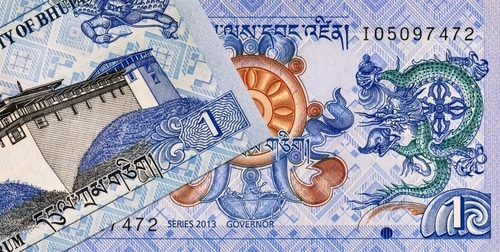The Bhutanese Ngultrum (BTN) is more than just the official currency of Bhutan; it’s a reflection of the country’s unique culture, economy, and growth. Whether you’re planning to visit Bhutan to immerse yourself in its breathtaking Himalayan landscapes or you’re an expat preparing for life in this magical kingdom, understanding BTN is vital.
This guide offers a clear breakdown of everything you need to know about the Bhutanese Ngultrum—from its origins and current value to practical tips for managing money in Bhutan.
What Is the Bhutanese Ngultrum?
The Bhutanese Ngultrum, abbreviated as BTN, has been the official currency of Bhutan since 1974. It is divided into smaller units called Chhetrum (1 Ngultrum = 100 Chhetrum) and was introduced as a direct replacement for the Indian Rupee in Bhutanese transactions. However, to this day, the Ngultrum is pegged to the Indian Rupee at a 1:1 ratio, and the two currencies are used interchangeably within Bhutan.
The term “Ngultrum” is derived from the words “ngul” for “silver” and “trum” for “coin,” reflecting Bhutan’s history of using silver coins as currency.
Characteristics of the Bhutanese Ngultrum
1. Denominations
The Ngultrum is available in both coins and notes.
- Coins are predominantly minted in denominations of 1, 5, and 10 Chhetrum, as well as 1, 2, and 5 Ngultrum.
- Banknotes are issued in denominations of 1, 5, 10, 20, 50, 100, 500, and 1,000 Ngultrum.
Each denomination features vibrant illustrations of Bhutanese heritage, such as Dzongs (fortresses), traditional arts, and religious motifs, showcasing the cultural richness of the nation.
2. Pegged to the Indian Rupee
One unique feature of BTN is its fixed exchange rate with the Indian Rupee (INR). Both currencies hold equal value (1 BTN = 1 INR). This pegging simplifies trade between Bhutan and India, which is Bhutan’s largest trading partner.
3. Symbol and Code
The symbol for Ngultrum is “Nu.” or “BTN” for international banking purposes.
Practical Tips for Using the Ngultrum in Bhutan
1. Where to Exchange Currency
If you’re bringing foreign currency into Bhutan, it’s essential to know where to exchange it for Ngultrum.
- Authorized Forex Counters: You can exchange currency at local banks such as the Bank of Bhutan, Bhutan National Bank, and Druk PNB Bank.
- ATMs: While a reliable option in urban centers like Thimphu and Paro, ATMs might not work for all international cards.
- Indian Rupee: Indian visitors can use INR directly, but bear in mind that higher denominations of INR 500 and 2,000 may not be widely accepted.
2. Cash Is King
Bhutan is still largely a cash-based economy, especially outside major cities. Carry sufficient cash for rural travel, as credit card facilities may be unavailable in smaller towns or remote areas.
3. Credit Card Use
Urban areas and high-end hotels or restaurants often accept international credit cards. Visa and Mastercard are the most commonly accepted options. However, always keep some cash on hand for smaller establishments and local markets.
4. Tipping Practices
Tipping in Bhutan isn’t mandatory but is appreciated, especially for exceptional service. Tipping in Ngultrum is preferred and ensures smoother transactions.
5. Sending and Receiving Money
For expats or frequent travelers to Bhutan, using platforms such as Remitly makes transferring money back home safe and convenient. With no hidden fees and easy tracking, it’s a great way to manage finances while working in Bhutan.
Why Understanding the BTN Matters
1. Budgeting for Travel and Accommodation
Familiarity with BTN helps you set realistic budgets for your stay. A good rule of thumb is to always account for both urban and rural travel expenses, as these can vary significantly. The daily spending of an average tourist in Bhutan can range between Nu. 2,000 and Nu. 5,000 depending on your travel style.
2. Support Bhutan’s Local Economy
When you understand and use the local currency, you contribute directly to Bhutan’s economy. This is particularly important for small businesses and artisans who rely on domestic transactions.
3. Navigate Exchange Rates Confidently
Knowing that the BTN is pegged to the INR can save you from unnecessary anxiety about fluctuating currencies. However, if you’re coming from elsewhere, make sure to compare exchange rates before converting your money.
Fun Facts About the Bhutanese Ngultrum
Here are some little-known facts to help you appreciate the BTN even more:
- Cultural Representation: BTN notes feature iconic Dzongs, representing Bhutan’s unique blend of culture, spirituality, and administration.
- Environmentally Friendly: Bhutan’s monetary policy aligns with its commitment to being eco-friendly. Coins are often reused, and bills are designed to be durable.
- Modern Innovations: Bhutan’s government is exploring digital payment systems. The launch of the Bhutan QR Code is an effort to modernize the payment ecosystem through cashless transactions.
Ease Your Financial Journey in Bhutan
Understanding the Bhutanese Ngultrum is an essential step in making your travel or new life in Bhutan enjoyable and stress-free. Whether it’s exchanging money, adhering to local customs, or choosing the best way to send funds internationally, staying informed goes a long way.
For smoother financial transactions and peace of mind, services like Remitly ensure that your finances are secure, fast, and accessible. Start your financial planning today by exploring our reliable, easy-to-use platform. Sign up now and experience how seamless money transfers can empower your global lifestyle.
